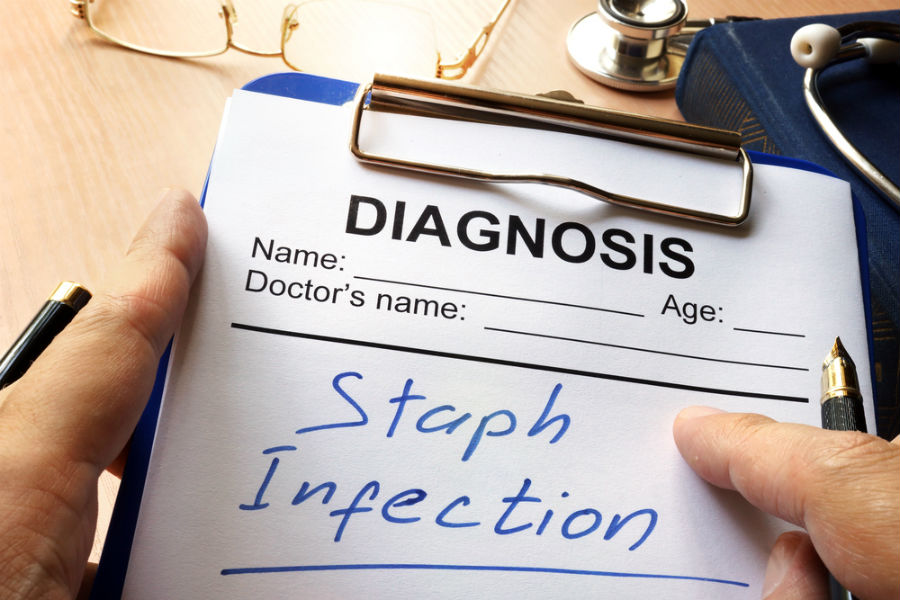
About 33 percent of us coexist peacefully with Staphylococcus bacteria (staph) during our day-to-day lives. They reside on our skin and in our noses, and as long as they stay put, they don’t cause any issues.
However, if these hardy little microbes escape and infect other areas of our bodies, they can become a problem, fast. This is particularly true of methicillin-resistant Staphylococcus aureus (MRSA), antibiotic-resistant bacteria that are much harder to kill than the normal variety. MRSA is more common in healthcare facilities like hospitals, as the use of antibiotics is widespread and immunocompromised patients are more susceptible to infection.
Skin Abnormalities
Staph can easily infiltrate the skin if you scratch at a blemish or bug bite or accidentally pierce the skin with an infected nail. Fortunately, these infections are less serious than those that spread throughout the body. Depending on the extent of the infection, you may be able to clear it up with regular washing and protection, or you may require prescription ointment, oral antibiotics or surgical draining. Staph infections commonly take the form of:
- Boils and pimples – Red, raised bumps filled with pus.
- Impetigo – Sores most often seen on the faces of younger children. Eventually, the sores will ooze and crust over. Ecthyma, a worse form of impetigo, may cause deeper ulcers.
- Cellulitis – An infection deep in the skin that causes large areas of redness and swelling. This is most often seen in the lower legs and can quickly become serious if the infection spreads to the bloodstream. The skin may feel hot and the patient may develop a fever in severe cases.
- Scalded skin syndrome – A condition affecting children and infants under the age of five. The child will have a fever and possibly rashes or blisters, followed by skin peeling. The exposed skin will look red and be sensitive, as if the child was actually burned, and they will require immediate medical care for a safe recovery.
Food Poisoning
Not all cases of food poisoning are caused by spoiled foods, like rotten meat and moldy vegetables. Staphylococcus aureus bacteria are behind many cases of food poisoning. Though the bacteria die once cooked or pasteurized, any toxins created still linger in the food, and it is these toxins that make you sick.
You are most likely to get staph food poisoning by eating foods prepared or handled by someone who hasn’t washed or covered their hands, especially if the foods are then left out at room temperature. The biggest culprits are:
- Sandwiches
- Deli meats
- Baked goods and pastries
- Puddings
- “Salads” like chicken or macaroni salad
- Unpasteurized milk or cheese
Symptoms most commonly begin manifesting 30 minutes to six hours after consumption and may last for up to two days. They include:
In most cases, food poisoning will pass. Be sure to drink water and rest. If symptoms do not subside within a few days, you may need to go to a hospital to receive an IV for hydration.
Sepsis
Also called septicemia, bacteremia or “blood poisoning,” sepsis is a condition where Staphylococcus bacteria enter the bloodstream. Your body will overreact to the infection and release chemicals to combat it. This excessive response has the potential to damage your bones, muscles and major organs. Sepsis may occur if a smaller staph infection has been left untreated or if an immunocompromised patient is exposed to bacteria in a medical setting. A contaminated medical device may be to blame, like an IV, surgical drain, catheter, dialysis tube, feeding tube, breathing tube, pacemaker or artificial joint.
A number of complications can occur as part of sepsis, such as pneumonia, osteomyelitis, meningitis, and endocarditis. The symptoms of sepsis are numerous and varied, and include:
- Low blood pressure
- High fever above 101 degrees Fahrenheit
- Hypothermia below 96.8 degrees Fahrenheit
- Accelerated heartbeat
- Quickened respiration rate
- Chills and feeling like your extremities are cold
- Rashes or patchy skin
- Skin that’s hot to the touch
- Sweatiness
- Dizziness
- Confusion or delirium
- Pain
- Trouble breathing
If a patient does not receive immediate emergency treatment for sepsis, they will likely go into septic shock and die.
Toxic Shock Syndrome
During menstruation, the prolonged use of highly absorbent tampons can cause toxic shock syndrome (TSS). Use smaller tampons and change them every four to eight hours to avoid TSS.
In some cases, females can also get TSS by using a diaphragm or vaginal sponge. Everyone – including post-menopausal females, males, and children – can also get TSS through a sore, burn or wound or after having a viral infection.
TSS is a rare medical condition that often manifests without warning and requires immediate attention in a hospital. The following symptoms may indicate TSS:
- Sunburn-like rash on the palms of your hands and soles of your feet
- High fever
- Low blood pressure
- Nausea
- Vomiting
- Diarrhea
- Stomach pain
- Redness of the eyes, mouth and throat
- Achiness
- Headaches
- Confusion and disorientation
- Seizures
Treatment for Staph Infections at Complete Care
Staph infections are a frightening possibility, but if you catch the signs and symptoms early on, you can prevent the onset of serious infection and sepsis. At Complete Care, our medical team can treat bites, burns, and cuts both before and after infection. We are also equipped to handle life-threatening emergencies and concerning symptoms like high fever, nausea, vomiting, irregular heartbeat, dizziness, and seizures. Visit the Complete Care location nearest you for quick diagnosis and compassionate medical treatment.
Sources
https://www.cdc.gov/mrsa/healthcare/index.html
https://www.cdc.gov/foodsafety/diseases/staphylococcal.html
https://www.foodsafety.gov/food-poisoning/bacteria-and-viruses#staphylococcus
https://www.mayoclinic.org/diseases-conditions/sepsis/symptoms-causes/syc-20351214
